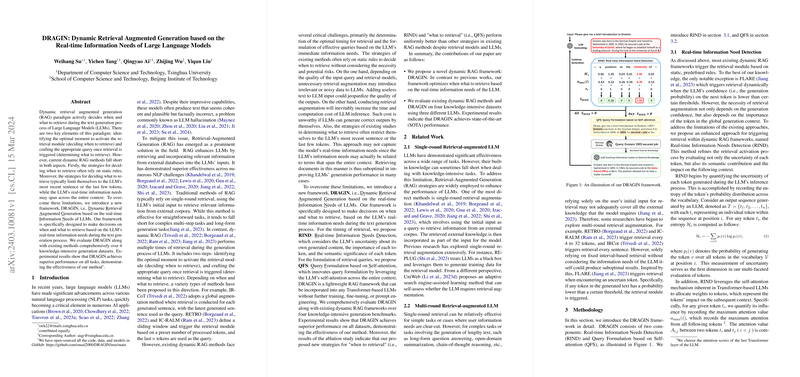Dynamic Retrieval Augmented Generation for LLMs Informed by Real-time Information Needs
Introduction to DRAGIN
Dynamic Retrieval Augmented Generation (RAG) represents a forward-looking approach within the field of LLMs. The core innovation of DRAGIN (Dynamic Retrieval Augmented Generation based on the real-time Information Needs of LLMs) lies in its sophisticated method for determining "when" and "what" to retrieve during LLM's text generation. This capability addresses a crucial gap in existing dynamic RAG methods, which are often hamstrung either by static rules for deciding when to activate retrieval or by limited strategies for formulating queries, typically confined to the LLM's most recent outputs. DRAGIN introduces a more refined framework, highlighted by two principal components: Real-time Information Needs Detection (RIND) and Query Formulation based on Self-attention (QFS). These innovations allow DRAGIN to adaptively and accurately identify the need for external knowledge, thereby optimizing both the timing and content of information retrieval.
DRAGIN Framework Overview
Real-time Information Needs Detection (RIND)
RIND revolutionizes the way retrieval timing is determined in dynamic RAG systems. By concentrating on three aspects—token uncertainty, significance, and semantic contribution—RIND assesses the necessity for retrieval based on the LLM's confidence and the current token's importance and semantic value. This method represents a departure from existing retrieval activation strategies, which are primarily rule-based and do not consider the comprehensive context of the generated text. RIND, with its multi-faceted evaluation, enables a more precise and context-aware trigger for information retrieval.
Query Formulation based on Self-attention (QFS)
The second pillar of the DRAGIN framework, QFS, innovates in the area of query formulation. Where past approaches were confined to using a limited portion of the LLM's recent output, QFS leverages the LLM's self-attention mechanism to identify tokens across the full context that are most relevant to the current information need. This strategy acknowledges that informative cues for retrieval may be spread throughout the text, not just in the most recent outputs. As a result, QFS can formulate queries that are more aligned with the LLM's real-time information needs, facilitating more effective retrieval that, in turn, improves the LLM's text generation performance.
Experimental Insights
DRAGIN's effectiveness was comprehensively assessed across four knowledge-intensive generation datasets. The results underscored DRAGIN's superior performance in correctly identifying when to retrieve and in formulating queries that accurately reflect the LLM's information needs at any given moment in text generation. Notably, DRAGIN demonstrated a pronounced advantage in tasks requiring complex reasoning or extensive knowledge, showcasing its ability to effectively harness external information in service of generating coherent, contextually grounded outputs.
Implications and Future Directions
Theoretical Implications
DRAGIN's novel approach to dynamic retrieval augments our understanding of how to more deeply integrate external knowledge sources with LLMs. By effectively marrying the LLM's internal generation processes with external information retrieval, DRAGIN represents a meaningful step forward in achieving more contextually aware and information-rich text generation.
Practical Implications
From a practical standpoint, DRAGIN offers a scalable and efficient solution to improve the quality of LLM-generated text, especially for applications requiring factual accuracy and depth of knowledge. Its adaptability to different LLM architectures and compatibility with various information sources also positions DRAGIN as a versatile tool for a broad spectrum of NLP applications.
Future Research Directions
Looking ahead, the potential refinements of DRAGIN's components, especially in optimizing the thresholds for RIND and expanding the capabilities of QFS, present exciting avenues for future research. Moreover, exploring the integration of DRAGIN with other LLM enhancements, such as custom fine-tuning or advanced prompting techniques, could further elevate the potential of LLMs in diverse domains.
Conclusion
DRAGIN not only addresses the existing limitations of dynamic RAG frameworks but also pioneers a more nuanced and context-aware approach to leveraging external information for LLM-enhanced text generation. By judiciously determining when and what information to retrieve, DRAGIN markedly improves the utility and accuracy of LLM output, charting a promising path for future developments in the field.
